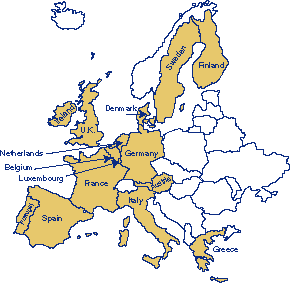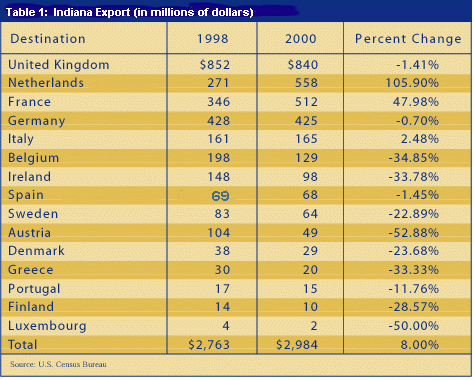The European Connection
I spent three weeks this May with my colleague Charles Bonser and 20 IU graduate students (from the School of Public & Environmental Affairs, the Law School and the Kelley School of Business) learning about the European Union (E.U.) in Paris, Brussels and Germany.
Over the past several years, the tense trade relations between the United States and the European Union have been a hot topic. To read the newspapers, it seems that we share little in common and stand on the verge of trade and regulation war. They give money to Airbus; we subsidize Boeing too much. They keep our bananas from reaching their stores; we ban their meat. They don't like the way we use microbiology in agriculture; we don't like the way they subsidize their farmers. They think our foreign sales corporations are illegal; we don't like the export subsidies they give to companies seeking new locations in Europe. They ban the union of GE and Honeywell after we similarly halted Deutsche Telekom's acquisition of VoiceStream.
The European Union

While we can enumerate many areas of disagreement, we shouldn't exaggerate their importance for the ongoing business of trade. After all, we have contentious issues with most of our major trading partners: Japan (autos), China (human rights), Canada (lumber, beer), and Mexico (immigration, environment), for example. The truth is that strategic trading partners are also often engaged in fierce competition - if not for goods, then for entertainment, culture, workers or capital. Most of us do not understand the complexity of these issues nor the strategies for resolution. At times, the appropriate approach may be toughness and show of strength. Other times call for cooler heads and compromise.
Both sides have much to risk in the U.S./E.U. relationship. We depend heavily on each other for goods, services, real capital, finance and defense. Hoosiers should bet on more cooperation and more competition as we move ahead into the future. Our relationship with the European Union won't always be nice and cordial, nor smooth and linear, but it should move in the general direction of more integration.
The European Union is an important destination for Indiana exports. Hoosiers count on E.U. countries buying their products. Slow growth in Europe and a depreciating euro have not helped Indiana exports during the last two years. Nevertheless, Indiana exports to the 15 E.U. nations have increased (though not equally with all goods and all countries). What follows is a summary of the E.U./Indiana export connection.
Indiana exported $2.99 billion in goods and services to the 15 E.U. nations in 2000. That amounted to 19.4% of all Indiana exports to the world that year. Canada and Mexico together accounted for about three times that much, leaving only another 21% for the rest of the world. Thus, after Canada and Mexico, the E.U. countries are the next most important destinations for Hoosier products. The United States exported $164.8 billion to the E.U. countries in 2000 - about 21% of its exports to the world. Indiana's $2.99 billion equaled about 1.8% of the nation's exports to the European Union.
Minnesota leads the Midwest in its dependence on the European Union for export sales; 30% of Minnesota's exports go to the E.U. countries. Kentucky sends 28% of its goods to the European Union. Ohio and Michigan have the least reliance on the E.U., 17% and 14% respectively. Indiana, Illinois, Wisconsin and Tennessee devote from 19% to 21% of their exports to Europe.
As Table 1 shows, the United Kingdom is the largest purchaser of Indiana exports, followed by the Netherlands, France and Germany. Comparing Indiana exports over the two-year period from 1998 to 2000 shows that the Netherlands is the fastest-growing E.U. destination, with exports more than doubling over that time period. In fact, the Netherlands and France are the only two E.U. countries with significant increases in purchases of Indiana goods. Indiana has seen significant declines in sales to Belgium, Ireland and Austria. The downward pull exerted by these destinations is important: While Indiana exports to the world increased by 25% over the past two years, exports to the European Union rose by only 8%.

What does Indiana sell to the E.U. countries? Mostly machinery. Combining machinery and electrical machinery, the European Union purchased $903 million in 2000. That was up from $669 million in 1998, amounting to a 35% increase over those two years. The main machinery items sold were gas turbines (mostly sold to the United Kingdom, France, Switzerland, Italy and Portugal), parts for machine engines (United Kingdom and Germany), and insulated wire and cable (the Netherlands). Organic chemicals and pharmaceuticals were the next-largest exports to the European Union, together accounting for $673 million and an increase of $145 million between 1998 and 2000. Steroid hormones, glycosides, antibiotics and other medications dominated the sales, mostly to France and Germany.
Machinery, chemicals and pharmaceuticals exported to the richest places in Europe explain the Hoosier connection to the European Union. As the euro increases in value; as the E.U. economy gathers strength; and as the European Union itself becomes a more open, integrated and dynamic marketplace; Hoosiers should find new and better opportunities for doing business. Tiffs among Europeans and with the U.S. government will continue as they always have, but the probabilities suggest that the European Union is not a location to be avoided or ignored.
Larry S. Davidson, Professor of Business Economics & Public Policy,
Kelley School of Business, Indiana University
